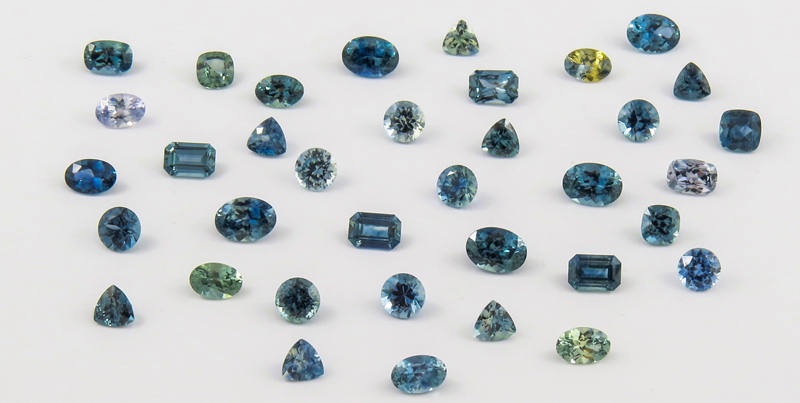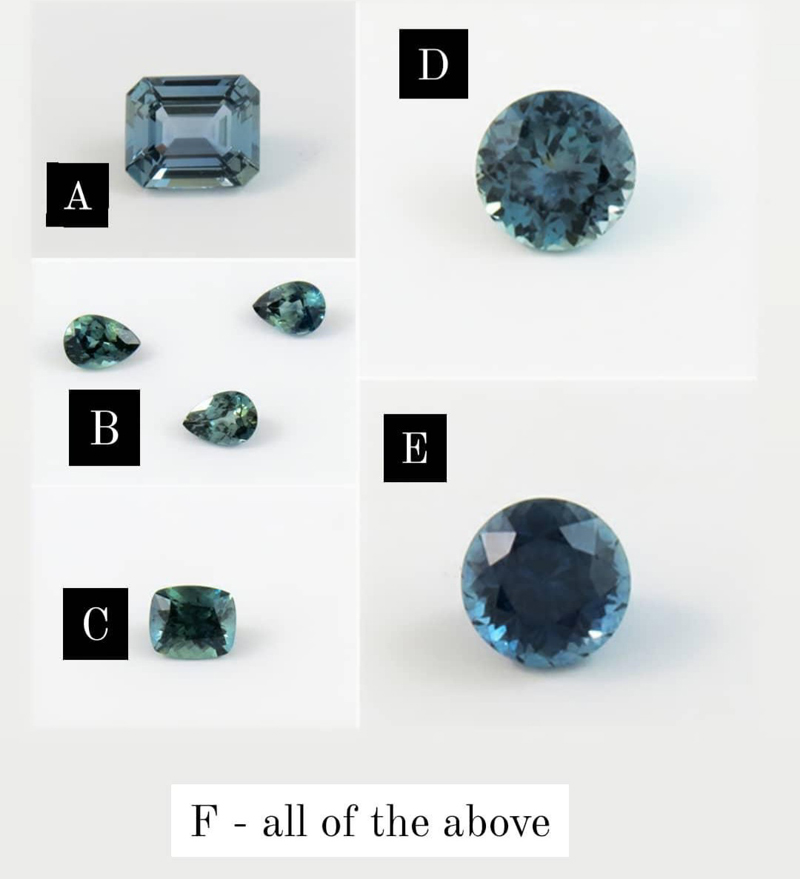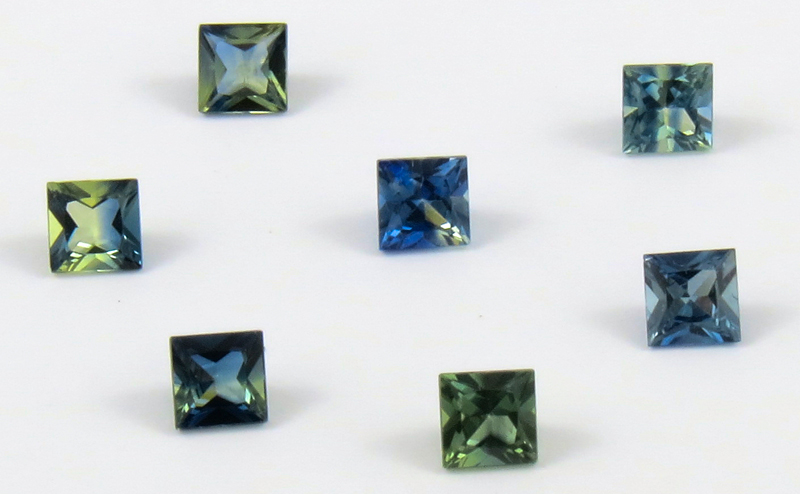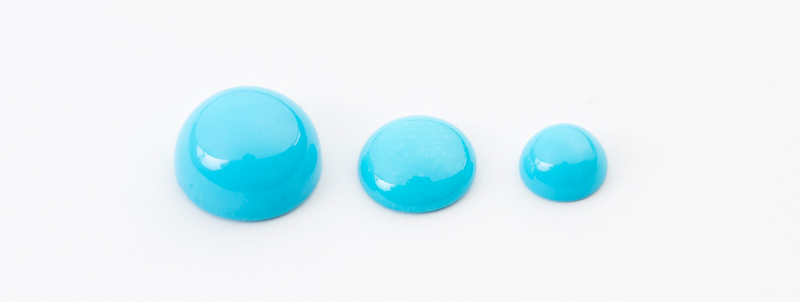By Bénédicte Lavoie

Photos by Bénédicte Lavoie
Teal has been a very hot colour for the past few years. Indeed, as a gem dealer who specializes in coloured gemstones, this author can attest to a spike in teal and green sapphire sales throughout 2022 and into 2023. What is teal, though? Why is it such a popular choice? Most importantly, what does the price range for gems in this category look like?
Teal is named after the blue and green mix of colour seen on the neck of the Eurasian Teal duck. In sapphires, the best way to describe ideal teal colour is as an equal mix of green and blue.
In an article published in the February 2021 issue of Jewellery Business, I detailed the results of an Instagram-conducted survey on colour interpretation.1 Specifically, I presented a range of gemstones and asked participants to share their idea of which gems best represented the colour teal (Figure 1). The options were all Montana or Australian sapphires. Gemstones ‘B’ and ‘D’ received more than 43 per cent of the collective votes, and 15 per cent of respondents considered all of the gem options to be in the teal category.

While the colour is, optimally, a 50/50 mix of green and blue, the “teal” descriptor is often attributed to a significant range of colours, from slightly greenish blue (similar to gemstone ‘E’), to almost forest green. Further still, some attribute the colour as a mix of yellow and blue, or green and blue colour zoning. Every teal sapphire is certainly unique.
Why is teal so popular?
When it comes to overall preference—whether for paint, cars, clothes, gemstones, or beyond—blue is the most popular colour choice in the world, followed closely by green. With this fondness in mind, it is really no surprise teal gems are so popular.
Teal sapphires are a fun choice, and they offer incredible variety. These stones tend to attract a more alternative and daring crowd—individuals who prefer to stay away from more traditional colours and also gravitate toward different cuts and styles. This is one of the reasons why we often see teal sapphires in alternative fancy cuts (i.e. freeform, portrait, geometric shapes) as compared to their more traditional blue counterparts. Additionally, given teal colouring is often caused by colour zoning, a cutter might craft a sapphire in a way that creates a more homogenous mix or reflection of both colours, or cut the gem into a parti-coloured stone.
If we consider the range of possible shades, the variety of cuts (i.e. traditional, alternative fancy, etc.), and the myriad of jewellery design styles in existence, it is clear every piece crafted with teal sapphires results in a unique heirloom.
What does the price look like?
Aiding in these stones’ popularity is the fact they can be very budget friendly—especially when they are on the smaller side.
Most markets obey the supply and demand law, and the gemstone industry is no different. We have seen a slight increase in teal sapphires in the last few years, but this mainly applies to large stones with very optimal colour. Even still, these stones are often less than half the price of the same size in a fine quality blue sapphire.
Trends
Using the 2015 and 2022 November/December issues of The GemGuide as reference, we can effectively compare and track changes in the prices of sapphires in the teal colour category.
Listed under “Corundum-Green Sapphires,” the guide includes the Gemological Institute of America (GIA) colours of green-blue, very strong bluish green, bluish green, green, slightly yellowish green, yellowish green, strongly yellowish green, and yellow green. Given this wide range of shades, I opted to specifically compare the “upper extra fine” category for greens with the “upper fine” category for blues. I want to compare the top of these teals and green colours to the quality of blues we are used to seeing on the Canadian market, which is a nice, saturated medium-dark blue.
In 2015, green sapphires were more than three times cheaper than blues weighing one to 2.99 carats (as opposed to half the price of blue in 2022). For stones larger than three carats, green sapphires were almost a fifth of the price of blues in 2015 (again, half of the price in 2022).
The price of blue sapphires has been stable since 2015, while green sapphires have doubled in price.

Where do they come from?
While, historically, most teal and green sapphires have come from Australia, much of the recent infatuation stems from the online buzz of Montana sapphire varieties. Teal sapphires can also be found in Madagascar, Kenya, and Nigeria; however, in the past few years, these countries have restricted the export of rough sapphire.2
Australia
As mentioned above, Australia served as the primary source of green and teal sapphires for many years. Indeed, sapphires from Down Under are commonly found in blue, green, and yellow. These stones are usually heat-treated, which makes them clearer by removing the silk. While this might slightly affect colour, this treatment is focused on removing inclusions and is permanent.
The two main sources for the Australian sapphires on the market today are Inverell (located in New South Wales) and the Anakie Gem Fields in central Queensland. There are other deposits, as well, but these sites are not large enough to provide viable mining.
According to an article by Terrence Coldham appearing in the 1985 issue of Gems and Gemology, a typical Inverell mine-run parcel may have about 10 to 20 per cent of the stone larger than two carats in weight (20 to 40 per cent small material), while the material recovered from Anakie is about 40 to 60 per cent medium sized (i.e. 0.50 to two carats) and 30 to 40 per cent small material (0.20 to 0.50 carats).3
On average, most of the cuttable material is less than two carats in its rough state. Clean stones larger than 10 carats do occur, but are quite rare.3
Australia sapphires offer several advantages. They are:
- Budget friendly
- Significant in size (three carat and larger)
- Available in parti sapphire variety
- Exist in a range of colours
- Traceable and ethically mined
One drawback of these sapphires, however, is they are sometimes dark or inky.
United States: Yogo Gulch
There are three main producing sapphire mining areas in Montana. The rarest natural “royal” blue and purplish-blue sapphires originate from a small-scale hard rock underground mining operations in Montana called Yogo Gulch. Recently, the volume of production from Yogo has been very small (close to non-existent), with the sapphires produced often small in size and flattened crystals. As such, fine, polished Yogo sapphires, larger than one carat, are exceedingly rare and command the highest price for any source of sapphires in America. Given the largest volume of the production from Yogo was in the early part of the last century, this means most larger sapphires from this region are found in estate jewellery pieces from the 1920s to the ‘40s.
United States: Missouri River and Rock Creek
Montana sapphires were first found by river gold miners in the Missouri River in the 1860s, then by gold prospectors in the area of Rock Creek in 1892. These sites were exploited in the early 1900s.
Before the 1940s, Montana’s alluvial sapphire deposits were primarily used in the watch industry, but production fell dramatically with the advent of synthetic sapphire in watch bearings.4 The small-scale operations mainly produced pastel-coloured stones, which were not fashionable, nor economically viable. As such, for several decades, sapphires extracted in Montana were primarily used for abrasives. This all changed in the 1980s and ‘90s with the development of heat treatment techniques, which were able to transform the sapphires’ silky greenish colours into beautiful clean, deep blue, greenish blue, and other fancy colours.
Currently, there are active mining operations at alluvial deposits along the upper Missouri River and Rock Creek.4 The sapphires produced are bought by either gem-cutters or dealers. The latter often send the rough overseas for heat treatment and cutting before selling the gems to those working in the jewellery industry. Heat treatment facilities and lapidary service are also available in the area for tourists who travel to explore the region.
Most cut Montana sapphire are less than one carat. Stones larger than three carats are extremely rare. Further, natural and no-heat sapphires are exceedingly rare from both the Missouri River and Rock Creek and, as such, are quite valuable.
Rock Creek has been producing, by far, the largest volume of Montana sapphires over the last decade, which has resulted in a predictable source of supply for “teal” varieties.
Montana sapphires offer several advantages, including:
- Beautiful colour. Most gems are deep blue with green undertones when heat treated.
- Excellent traceability, adhering to the strict environmental and labour law requirements in the State of Montana.
Disadvantages include:
- Large stones are quite rare. Approximately 80 per cent of sapphires produced at Rock Creek result in cut polished stones ranging between 0.10 carat to less than a carat.
- Significant price difference for smaller stones as compared to larger varieties.

Madagascar
Madagascar is famous for its amazing variety of gemstones and is among the most significant sources for sapphires. There are many different areas on the island that produce sapphires of all colours, including teal and green. Both unheated and heat-treated Madagascar stones can be found on the market in all sizes (including varieties larger than four carats).
Given these stones are usually mined by artisanal operations and then sold to Sri Lankan or Thai dealers to be exchanged in markets, it is difficult to ensure good traceability and reliable data. The discovery of deposits often leads to gem rushes in some areas, creating small villages and building a small economy among miners. While this is positive in many ways, this type of rush can also be damaging to the environment, as mines are often built quickly without proper engineering.
Madagascar sapphires offer many advantages. They are:
- Beautiful and available in deep optimal colours
- High in carat count
- Often unheated
- At a good price point for larger stones
Traceability and the environmental impact of mining are significant drawbacks to for Madagascar sapphires.
What other stones exist in teal?
While sapphires are an ideal gemstone for everyday wear and for engagement rings, they might not be the preferred choice for shoppers on the hunt for a teal piece of jewellery. Indeed, not everyone has the budget for these precious stones, or they might be looking for a size/weight that might not exist in sapphire. Fortunately, a wide range of gems can be found in teal! There are many options available beyond sapphire.
London blue topaz
Topaz is a great alternative to teal sapphires. While these stones are more on the blue side, they have green and grey undertones. Further, they are available at a fraction of the price of sapphires and have a hardness of 8 on the Mohs scale.
Tourmaline
Tourmaline is available in almost every colour but is perhaps best known for its beautiful blue-green shade. In addition to being significantly less expensive than sapphire, tourmaline is a fantastic option for those looking for a stone larger than five carats.
Diamond
Diamond lovers will be delighted to discover that blue diamonds have a teal colour or undertone. Though not as green as some sapphires, these unique stones are excellent options for those who have their heart set on diamonds but love the teal colour.
Alexandrite
Another hard gemstone (8.5 on the Mohs scale), alexandrite is famous for its fascinating colour change from green to red/purple. Some high-quality varieties with a deeper colour will usually show a deep bluish-green colour as opposed to a yellow-green.
Turquoise options
In addition to the varieties listed above, there are also several gemstones available in turquoise that might please clients looking for a dash of playful colour.
- Cuprian (Paraiba) tourmalines: Displaying a neon blue-green, the cuprian tourmaline is the only transparent gem which is coloured by copper. These are sometimes called “Paraiba tourmalines” (though some purists only consider cuprian varieties recovered from Paraiba, Brazil, as worthy of this descriptor).
- Turquoise: Usually cut as cabochon because of its opaqueness, turquoise ranges in colour from light blue to a darker rich blue-green shade.
- Apatite: Due to its very neon colour, this stone might be mistaken for Paraiba tourmaline, but don’t be fooled. With a hardness of 5 on the Mohs scale, apatite is best suited for occasional pieces.
- Blue zircons: This variety is a great alternative for those who love bright turquoise colour. They also display a very high dispersion that will leave nobody indifferent.
Teal appeal
Available in a range of shapes, sizes, and selection, teal gemstones are a fun, fantastic option for gem-enthusiasts looking to stand out from the crowd. What’s more, stones of this colour cater to a range of price points, making them accessible and an easy addition to a jeweller’s showcase.
 Bénédicte Lavoie, FGA, is co-owner and vice-president of Pierres de Charme and specializes in fine coloured gemstones. She joined the family business after completing a bachelor’s degree in business and human resources (HR) management and was awarded the internationally recognized title of Fellow of the Gemological Association of Great Britain (FGA–Merit). Based in Montréal, Pierres de Charme supplies fine gemstones to jewellers, goldsmiths, and award-winning artists across Canada and the United States. Lavoie can be reached at info@pdcgems.com.
Bénédicte Lavoie, FGA, is co-owner and vice-president of Pierres de Charme and specializes in fine coloured gemstones. She joined the family business after completing a bachelor’s degree in business and human resources (HR) management and was awarded the internationally recognized title of Fellow of the Gemological Association of Great Britain (FGA–Merit). Based in Montréal, Pierres de Charme supplies fine gemstones to jewellers, goldsmiths, and award-winning artists across Canada and the United States. Lavoie can be reached at info@pdcgems.com.
References
1 Lavoie, B. Interpretation of colour, Jewellery Business, February 2021; 17(1): 18-21. https://www.jewellerybusiness.com/features/interpretation-of-colour
2 The author thanks Terry Coldham from Intogems and Warren Boyd from Potentate Mining for providing up-to-date information on the localities of these sapphires.
3 Coldham, T. Sapphires from Australia, Gems & Gemology, Fall 1985; 21(3): 130-146. https://www.gia.edu/doc/FA85.pdf
4 Hsu, T, Lucas, A, Kane, RE, McClure, S, Renfro, N. Big Sky Country Sapphire: Visiting Montana’s Alluvial Deposits, Gems & Gemology, Summer 2017; 53(2): https://www.gia.edu/gems-gemology/summer-2017-montana-alluvial-deposits





